Raytheon (General Dynamics) AGM/BGM/RGM/UGM-109 Tomahawk
The Tomahawk is the U.S. Navy's multipurpose strategic and tactical long range precision-guided cruise missile. Launched from surface ships and submarines, it was used in action in all recent major U.S. military engagements, and will remain one of the most important missiles in the U.S. inventory for quite some time.
The BGM-109 missile has been developed in several distinct variations, which are described in separate sections of this article. These variations include:
- SLCM (Sea-Launched Cruise Missile): BGM-109A/.../F, RGM/UGM-109A/.../E/H/M
- GLCM (Ground-Launched Cruise Missile): BGM-109G
- MRASM (Medium-Range Air-to-Surface Missile): AGM-109C/H/I/J/K/L
SLCM (Sea-Launched Cruise Missile): BGM-109A/.../F, RGM/UGM-109A/.../E/H/M Tomahawk
In 1971 the U.S. Navy began to study the possibility of a submarine-launched strategic cruise missile, either a larger design for launch from UGM-27 Polaris missile tubes or a smaller one for launch from torpedo tubes. In June 1972 the torpedo-tube missile was chosen, and design contracts were let to the industry in November that year for what was then called the SLCM (Submarine-Launched Cruise Missile). In January 1974, the two most promising designs were selected for a fly-off competition, and in 1975, the designations ZBGM-109A and ZBGM-110A were assigned to the designs of General Dynamics and LTV, respectively. After a few test flights by the YBGM-109A and YBGM-110A prototypes in February 1976, which included the critical transition from water to air in a sub-surface launch, the BGM-109 was declared winner of the competition. At that time, it had already been decided that the SLCM should also be launched from surface ships, and therefore the acronym was changed to Sea-Launched Cruise Missile. Flight testing of the YBGM-109A, including the TERCOM (Terrain Contour Matching) guidance system, continued during the following years.
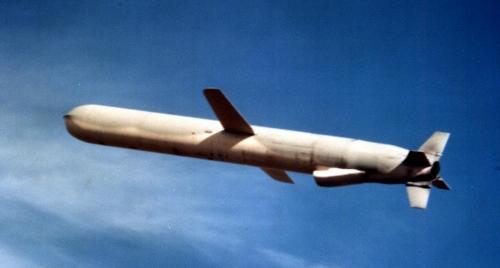 |
| Photo: U.S. Navy |
| BGM-109 (exact model unknown) |
In January 1977, the Carter administration initiated a program called JCMP (Joint Cruise Missile Project), which directed the USAF and the U.S. Navy to develop their cruise missiles using a common technology base. At that time, the Air Force was developing its AGM-86 ALCM (Air-Launched Cruise Missile). One consequence of JCMP was that only one cruise missile propulsion system (the Williams F107 turbofan of the AGM-86) and TERCOM guidance system (the McDonnell Douglas AN/DPW-23 of the BGM-109) would be further developed. Another one was a fly-off competition for the ALCM role between the AGM-86B and the AGM-109, an air-launched derivative of the YBGM-109A. After flights between July 1979 and February 1980, the AGM-86B was declared winner of the competition and the AGM-109 ALCM development was stopped.
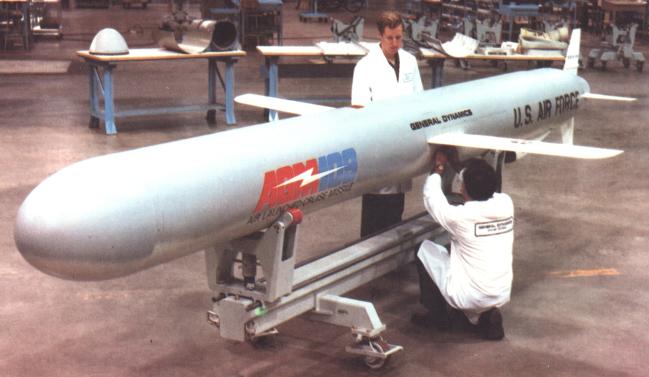 |
| Photo: General Dynamics |
| AGM-109 |
Development of the BGM-109 SLCM had of course continued during the ALCM evaluation. In March 1980, the first surface-ship launch of a production BGM-109A Tomahawk occurred from the USS Merrill (DD-976). This was followed in June that year by the launch of a production missile from the submarine USS Guitarro (SSN-665). Operational evaluation continued in the following years, and the Tomahawk SLCM was finally declared ready for service in March 1983. The initial versions, both also known as Tomahawk Block I, were the strategic BGM-109A TLAM-N (Tomahawk Land-Attack Missile - Nuclear) with a thermonuclear warhead and the BGM-109B TASM (Tomahawk Anti-Ship Missile) with a conventional warhead against surface-ships. Initially, the missile variants for the different launch environment options were designated by suffix letters, BGM-109A-1 and -109B-1 being surface-launched and BGM-109A-2 and -109B-2 submarine-launched. In 1986, this was changed to the use of R-for-Surface and U-for-Underwater launch environment letters:
| Old Designation | New Designation |
|---|---|
| BGM-109A-1 | RGM-109A |
| BGM-109A-2 | UGM-109A |
| BGM-109B-1 | RGM-109B |
| BGM-109B-2 | UGM-109B |
The RGM-109A is launched from MK 143 box-launchers or (in newer installations) MK 41 VLS (Vertical Launch System) cells with the help of a solid-propellant rocket booster. After the missile has cleared the launcher, the four tailfins are extended, followed by the deployment of the two straight wings. When this is completed, the ventral air intake for the Williams F107-WR-400 turbofan cruise engine extends, the spent booster is jettisoned, and the turbofan started. The Tomahawk is guided to its target by a system called TAINS (TERCOM Assisted Inertial Navigation System) using a McDonnell Douglas AN/DPW-23 TERCOM (Terrain Contour Matching) system. In TERCOM, altitude information obtained by a radar altimeter is continuously matched to a preprogrammed radar map of the area below the missile, so that the Tomahawk can effectively follow a detailed predetermined flight path. This path can include several waypoints to change altitude and direction, e.g. for flying around hills to be concealed from detection by point-defenses around the target for as long as possible. The accuracy of the TAINS guidance is around 80 m (260 ft) CEP, which is good enough for the RGM-109A's variable-yield (5 kT - 200 kT) W-80-0 thermonuclear warhead.
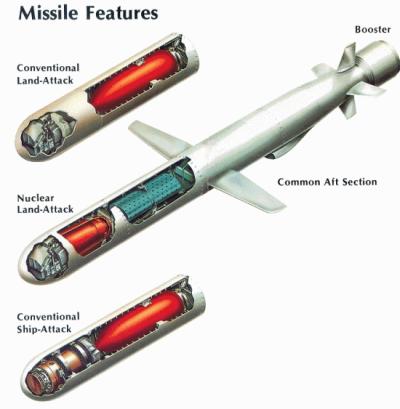 |
| Image: via FAS |
| From top: BGM-109C, BGM-109A, BGM-109B |
In an UGM-109 underwater launch, the missile remains enclosed in its transport canister until it has cleared the torpedo tube. The canister is then ejected, and the booster ignites to propel the missile to the surface. After it is fully airborne, some protective covers are jettisoned, and the flight procedes as in a surface launch. Newer SSNs also have vertical launch tubes for the UGM-109 missile.
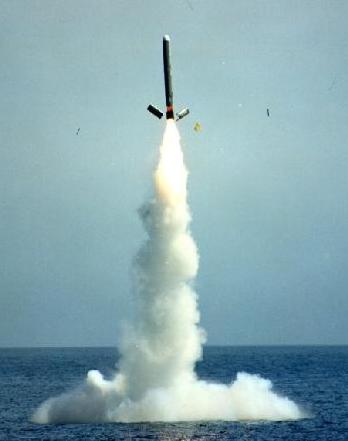 |
| Photo: U.S. Navy |
| UGM-109 (exact model unknown) |
The BGM-109B (later RGM/UGM-109B) TASM was developed concurrently with the BGM-109A TLAM-N, and was actually the first variant to be deployed in operational status. Instead of TERCOM (which is obviously useless over water), the TASM uses a radar guidance system very similar to that of the AGM/RGM/UGM-84 Harpoon anti-ship missile, including the latter's strapdown three-axis attitude/heading reference system and AN/DSQ-28 J-band active radar seeker. The missile is launched in the general direction of the target and at some distance from the expected target position, it enters a serpentine flight pattern to search for it using both passive radar to scan enemy emissions and active radar to lock on a detected target. Once the seeker has locked on a target, the RGM/UGM-109B proceeds towards it at very low altitude (sea-skimming). Manoeuvers after lock-on can include short pop-ups to get a better fix on the target position and/or course changes to strike the target from an unexpected direction. The missile is armed with a 450 kg (1000 lb) WDU-25/B high-explosive blast-fragmentation warhead, and can hit the target either from the side or from the top after a terminal pop-up manoeuver.
The BGM-109C (initially BGM-109C-1 and -2, but changed in 1986 to RGM-109C and UGM-109C) TLAM-C (Tomahawk Land-Attack Missile - Conventional) is a conventionally-armed (same WDU-25/B warhead as -109B TASM) missile for long-range strikes against high-value targets. It entered U.S. Navy operational service in 1986. The TLAM-C (also known as Tomahawk Block II) uses the same INS/TERCOM suite as the -109A TLAM-N for mid-course guidance. For higher accuracy in the terminal phase of the flight, it uses an AN/DXQ-1 DSMAC (Digital Scene Matching Area Correlation) system, because the conventional warhead requires higher precision to be effective. DSMAC is an electro-optical sensor system which takes images from the ground below the missile and compares these to reference images stored in the on-board computer. Any deviations lead to a course correction of the Tomahawk missile, and the system's accuracy is about 10 m (30 ft) CEP. The original TLAM-C Block II had only one mode of final approach, it always flew straight into the side of the target. Early in the development program, however, the BGM-109C software was upgraded to Block IIA. This allows pre-launch selection of two additional attack modes. The first of these is a pop-up/terminal-dive manoeuver, and the second is known as PWD (Programmed Warhead Detonation). Using PWD, the WDU-25/B warhead is detonated while the missile is flying directly over the target, making it especially effective against targets behind a protective shielding like a revetment.
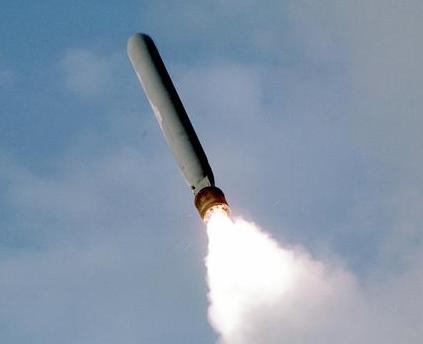 |
| Photo: U.S. Navy |
| RGM-109C |
The Tomahawk Block IIB is designated BGM-109D (intially BGM-109D-1 and -2, but changed to RGM-109D and UGM-109D before it entered service) TLAM-D (Tomahawk Land-Attack Missile - Dispenser). It is similar to the TLAM-C (also using the TAINS/DSMAC guidance package), but in place of the unitary WDU-25/B warhead, it uses a warhead section with 166 BLU-97/B CEB (Combined Effects Bomblet) submunitions. The BLU-97/Bs can be dispensed in partial packages to attack several targets in one mission. The RGM/UGM-109D entered service with the U.S. Navy in 1988.
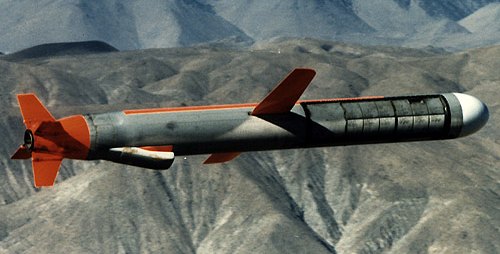 |
| Photo: Raytheon |
| BGM-109D |
The BGM-109E was a proposed improvement of the BGM-109B anti-ship missile, and the BGM-109F was to be a TLAM variant with an anti-airfield warhead (possibly using BLU-106/B submunitions). The BGM-109E/F versions were both cancelled in the mid-1980s, but the -109E suffix was later reused for the Block IV program and then again for the Tactical Tomahawk missile (q.v. below).
Operation Desert Storm in 1991 saw the first combat use of the Tomahawk missile, with 261 TLAM-Cs and 27 TLAM-Ds fired against Iraqi targets. The overall hit rate was reported as 85%. During the 1990s, Tomahawks were used whenever the United States needed to strike tactical and strategic targets at long range. Major operations included Operation Desert Fox (Iraq, December 1998) and Operation Allied Force (Serbia, April/May 1999), when several hundred Tomahawks were launched.
In the late 1980s, McDonnell Douglas (now Boeing) received a contract to develop the Block III upgrade for the TLAM-C/D. Block III had a significantly upgraded guidance unit, incorporating a GPS receiver to assist the TAINS system, and the improved DSMAC 2A which uses a wider imagery range and more scenes for the final fix. The Block III missiles were also upgraded with an improved F107-WR-402 engine with higher thrust and lower fuel consumption. The RGM/UGM-109C Block III also uses an improved WDU-36/B warhead which is smaller (thereby increasing fuel space) and lighter than the WDU-25/B but offers the same effect. The new warhead significantly increases the range of the Block III TLAM-C missile. The first launch of a Block III Tomahawk occurred in January 1991, and IOC was achieved in May 1993. All Block IIA/IIB missiles were upgraded to Block III standard when they were due for scheduled maintenance (every 3 to 4 years).
In 1994, Hughes (now Raytheon) started to develop the Block IV upgrade, also known as TBIP (Tomahawk Baseline Improvement Program), which had the goal to develop a single all-purpose missile, the RGM/UGM-109E TMMM (Tomahawk Multi-Mode Missile) for use against ships and land targets. For this purpose an imaging seeker (either a FLIR or a mm-wave radar) was to be installed, so that the computer could be fed with images of either ships or land targets. Other options under consideration for Block IV were autonomous target acquisition by the seeker and a datalink for retargeting in flight. The planned warhead was the WDU-36/B of the TLAM-C Block III, but the latter's F107 engine was to be replaced by the much cheaper Teledyne CAE J402-CA-401 turbojet. The RGM/UGM-109H THTP (Tomahawk Hard Target Penetrator) was a proposed Block IV missile with a penetrating warhead. However, the TBIP proved to be too expensive, and was cancelled in May 1996. The program was eventually replaced by the Tactical Tomahawk (q.v. below). The "Block IV" label, as well as designations of the TBIP missiles (RGM/UGM-109E and RGM/UGM-109H) were also "transferred" to the Tactical Tomahawk program.
The latest development of the Tomahawk SLCM is the Block IV RGM-109E/UGM-109E Tactical Tomahawk (a.k.a. "TacTom") variant. It was first proposed in 1998 as a low-cost replacement for the cancelled Block IV TBIP program. Tactical Tomahawk was originally known as Block V, but has been renumbered as Block IV. The major TacTom program goal was a missile which would cost significantly less (about one half) per production round than an up-to-date TLAM-C/D. Therefore a cheaper engine is used and the structure is lighter. The originally planned engine was the TBIP's J402-CA-401 turbojet, but this was changed during development to a Williams F415-WR-400/402 turbofan, causing a significant delay in the time schedule. Because of the lighter structure (which includes reducing the number of tailfins from four to three), the UGM-109E is unsuitable for launch from torpedo tubes, but can still be used from SSNs equipped with vertical launch systems. The RGM/UGM-109E also features a number of significant operational improvements. The missile can be reprogrammed in flight via an UHF satellite link to divert to any one of 15 pre-programmed alternate targets or to an arbitrary location defined by GPS coordinates. It can also loiter over the target area for some time while transmitting imagery from its on-board TV camera via the satellite link. The image can be used to assess battle damage and/or to retarget the missile.
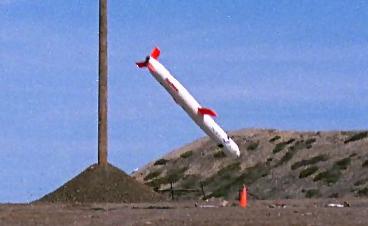 |
| Photo: U.S. Navy |
| RGM-109E |
The first flight of a TacTom test vehicle occurred in August 2002, and the first underwater launch of a UGM-109E succeeded in November 2002. The first LRIP (Low-Rate Initial Production) contract was awarded to Raytheon in October 2002. IOC (Initial Operational Capability) was officially reached in May 2004, when RGM-109E missiles were installed on USS Stethem (DDG-63). In August that year, Raytheon received a five-year contract for full-scale production of Tomahawk Block IV rounds to replenish the Navy's cruise missile arsenal. The RGM/UGM-109E Tactical Tomahawk version is armed with the WDU-36/B blast-fragmentation warhead of the TLAM-C Block III.
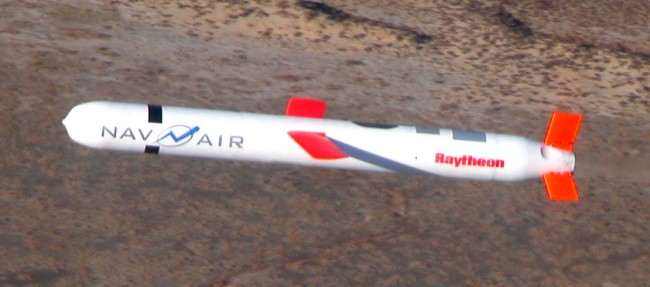 |
| Photo: U.S. Navy |
| UGM-109E |
A second variant of the Tactical Tomahawk was to be the TTPV (Tactical Tomahawk Penetrator Variant), armed with a new WDU-43/B penetrating warhead for use against hardened and/or underground targets, like storage bunkers for weapons of mass destruction. The first test flight of the TTPV, designated RGM-109H and UGM-109H (reusing the -109H suffix of the cancelled THTP penetrator version), was successfully conducted on 21 March 2003. However, the TTPV was not selected for production.
In 2020, the U.S. Navy and Raytheon began a program to modernize and upgrade the Block IV Tomahawk, resulting in the Block V missile. The designations RGM-109M/UGM-109M, allocated in 2019, might refer to the Block V, but this is unconfirmed. The baseline Block V version includes an upgrade to the navigation/communication system for improved in-flight (re-)targeting, and also replaces life-limited components to extend the missile's shelf-life. The first Block V Tomahawks, produced by converting existing Block IV missiles, were delivered to the Navy in 2021. The Block Va variant, called MST (Maritime Strike Tomahawk), has a terminal seeker (details about which are not available) to attack moving targets at sea. Block Vb features a new warhead, labeled JMEWS (Joint Multiple Effects Warhead System), which has been in development and test since at least 2010. JMEWS is a comined-effects warhead, keeping the primary blast-fragmentation effect while adding some penetration capabilities.
The Tomahawk versions currently in the U.S. Navy operational inventory are the RGM/UGM-109C/D TLAM-C/D Block III, the RGM/UGM-109E Block IV and the Block V. The original RGM/UGM-109A TLAM-N and RGM/UGM-109B TASM variants have been retired in the early 1990s. Including the ground-launched BGM-109G Gryphon, more than 4000 xGM-109 missiles of all variants had been built by 2004. Since then, several thousand Block IV and Block V missiles have been produced, and production of new missiles is continuing at a rate of around 100 per year. In 2020, the Navy announced that it plans to upgrade all existing Block IV missiles to Block V standard, and to retire the remaining Block III stockpile.
Specifications
Note: Data given by several sources show slight variations. Figures given below may therefore be inaccurate!
Data for RGM/UGM-109A/B/C/D/E:
| RGM/UGM-109A | RGM/UGM-109B | RGM/UGM-109C/E | RGM/UGM-109D | |
|---|---|---|---|---|
| Length | 5.56 m (18 ft 3 in) (w/o booster) 6.25 m (20 ft 6 in) (incl. booster) | |||
| Wingspan | 2.62 m (8 ft 7 in) | |||
| Diameter | 53.1 cm (20.9 in) | |||
| Weight | 1180 kg (2600 lb) (w/o booster) 1450 kg (3200 lb) (incl. booster) |
1310 kg (2900 lb) (w/o booster) 1590 kg (3500 lb) (incl. booster) |
1220 kg (2700 lb) (w/o booster) 1490 kg (3300 lb) (incl. booster) | |
| Speed | 880 km/h (550 mph) | |||
| Range | 2500 km (1350 nm) | 460 km (250 nm) | 1250 km (675 nm) Block III: 1600 km (870 nm) -109E: 1670 km (900 nm) | 870 km (470 nm) |
| Propulsion | Williams F107-WR-400 turbofan; 2.7 kN (600 lb) RGM/UGM-109C/D Block III: Williams F107-WR-402 turbofan; 3.1 kN (700 lb) RGM/UGM-109E: Williams F415-WR-402 turbofan Booster: Atlantic Research MK 106 solid-propellant rocket; 26.7 kN (6000 lb) for 12 s | |||
| Warhead | W-80-0 thermonuclear (5-200 kT) | 450 kg (1000 lb) WDU-25/B blast-fragmentation -109C Block III / -109E: 340 kg (750 lb) WDU-36/B blast-fragmentation |
166 BLU-97/B CEB (Combined Effects Bomblets) | |
GLCM (Ground-Launched Cruise Missile): BGM-109G Gryphon
As early as 1971 the U.S. Air Force had tentative plans to replace the retired MGM-13 Mace with a modern GLCM (Ground-Launched Cruise Missile) with TERCOM precision guidance and a small fuel-efficient turbofan engine. The plans became more firm in 1976, and in January 1977 the USAF was allowed to develop and field a GLCM derivative of the Navy's BGM-109 Tomahawk SLCM. The first launch of the BGM-109G Gryphon (sometimes spelled Griffin) GLCM from its mobile TEL (Transporter/Erector/Launcher) occurred in May 1980, and operational testing began in May 1982. The GLCM was operationally deployed in Europe from 1983 to counter (together with the U.S. Army's MGM-31C Pershing II) the Soviet RSD-10 Pioner (SS-20 Saber) mobile IRBM system.
The BGM-109G was very similar to the Navy's nuclear-armed BGM-109A except that a different W-84 thermonuclear warhead was used. The Gryphon was launched from a mobile TEL, which could hold four missiles. Like the BGM-109A, it used an INS/TERCOM guidance system with an accuracy of about 80 m (260 ft) CEP.
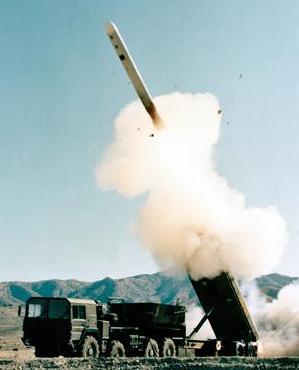 |
| Photo: USAF |
| BGM-109G |
In December 1987, the USA and the USSR signed the Intermediate Range Nuclear Forces (INF) Treaty, which abolished all medium- and intermediate-range nuclear armed missiles. Withdrawal of the GLCM began in 1988 and was completed in May 1991. A total of about 500 BGM-109G missiles had been built.
Specifications
Note: Data given by several sources show slight variations. Figures given below may therefore be inaccurate!
Data for BGM-109G:
| Length | 5.56 m (18 ft 3 in) (w/o booster) 6.25 m (20 ft 6 in) (incl. booster) |
| Wingspan | 2.62 m (8 ft 7 in) |
| Diameter | 51.8 cm (20.4 in) |
| Weight | 1200 kg (2650 lb) (w/o booster) 1470 kg (3250 lb) (incl. booster) |
| Speed | 880 km/h (550 mph) |
| Range | 2500 km (1350 nm) |
| Propulsion | Williams F107-WR-400 turbofan; 2.7 kN (600 lb) Booster: Atlantic Research MK 106 solid-propellant rocket; 26.7 kN (6000 lb) for 12 s |
| Warhead | W-84 thermonuclear (0.2-150 kT) |
MRASM (Medium-Range Air-to-Surface Missile): AGM-109C/H/I/J/K/L
In the late 1970s both the U.S. Navy and the USAF had plans for a tactical air-launched medium-range cruise missile. By 1978 it had become clear that Navy and Air Force would have to agree on a common missile, and in March 1980 General Dynamics was awarded a development contract for a MRASM (Medium-Range Air-To-Surface Missile) based on the AGM-109 Tomahawk, which had lost shortly before against the AGM-86B in the USAF's ALCM (Air-Launched Cruise Missile) competition.
The MRASM was planned in several different versions for both Navy and USAF. The Air Force variants were very similar in general arrangement to the BGM-109 SLCM missile family, except that the F107 turbofan engine was replaced by a much cheaper Teledyne CAE J402-CA-401 turbojet. Due to size and weight restrictions imposed by ammunition elevators on U.S. aircraft carriers and the maximum safe return weight of the A-6E aircraft, the Navy MRASM variants were significantly shorter and lighter than the USAF MRASMs. The shorter nose also necessitated the use of a slight sweep-back on the wings.
The initial MRASM version for the Navy was to be the AGM-109C, a conventional land-attack missile similar to the BGM-109C with a unitary warhead (most probably the TLAM-C's WDU-25/B). The AGM-109H was a USAF version also known as TAAM (Tactical Anti-Airfield Missile), and was to carry 28 BLU-106/B BKEP (Boosted Kinetic-Energy Penetrator) runway-cratering submunitions. The Navy's AGM-109J was either a low-cost derivative of the AGM-109C or a variant armed with a submunition dispenser. In any case, the -109J was cancelled very early in the MRASM program. The AGM-109C/H/J were all planned to use TERCOM/DSMAC guidance like the BGM-109C/D TLAM-C/D missiles. The designation AGM-109I was unofficially used by the U.S. Navy for a generic MRASM equipped with a low-cost TERCOM system and an IIR (Imaging Infrared) terminal seeker. This MRASM could serve both as land-attack and anti-ship missile. Planned versions with an IIR seeker were the USAF's AGM-109K with a WDU-25/B warhead, and the Navy's AGM-109L with a WDU-7/B warhead.
 |
| Drawing: via Friedman |
| From left: AGM-109H, AGM-109L |
The MRASM program was in trouble almost from the beginning, because the U.S. Navy was not very enthusiastic about it. They feared to get a very expensive missile, which would not be an ideal fit for their mission requirements. The USAF reportedly also wanted to kill the joint program, and therefore the whole MRASM effort was cancelled in 1984, without any versions having been built.
Specifications
Note: Data given by several sources show slight variations. Figures given below may therefore be inaccurate!
Data for AGM-109H/K/L:
| AGM-109H/K | AGM-109L | |
|---|---|---|
| Length | 5.84 m (19 ft 2 in) | 4.88 m (16 ft) |
| Wingspan | 2.62 m (8 ft 7 in) | ? |
| Diameter | 53.1 cm (20.9 in) | |
| Weight | 1200 kg (2700 lb) | 1000 kg (2200 lb) |
| Speed | Mach 0.7 | |
| Range | 2500 km (1550 miles) | ? |
| Propulsion | Teledyne CAE J402-CA-401 turbojet; 3.0 kN (680 lb) | |
| Warhead | AGM-109H: 28 BLU-106/B submunitions AGM-109K: 450 kg (1000 lb) WDU-25/B blast-fragmentation |
295 kg (650 lb) WDU-7/B blast-fragmentation |
Main Sources
[1] James N. Gibson: "Nuclear Weapons of the United States", Schiffer Publishing Ltd, 1996
[2] Norman Friedman: "World Naval Weapons Systems, 1997/98", Naval Institute Press, 1997
[3] Bill Gunston: "The Illustrated Encyclopedia of Rockets and Missiles", Salamander Books Ltd, 1979
[4] Hajime Ozu: "Missile 2000 - Reference Guide to World Missile Systems", Shinkigensha, 2000
[5] Kenneth P. Werrell: "The Evolution fo the Cruise Missile", Air University Press, 1985
[6] Nigel Macknight: "Tomahawk Cruise Missile", Motorbooks, 1995
[7] Norman Friedman: "US Naval Weapons", Conway Maritime Press, 1983
[8] Raytheon Website
[9] NAVAIR: Tomahawk Fact Sheet
[10] Various web resources, referenced by Wikipedia: Tomahawk (Missile Family)
Back to Current Designations Of U.S. Unmanned Military Aerospace Vehicles
Back to Directory of U.S. Military Rockets and Missiles
Last Updated: 22 December 2024